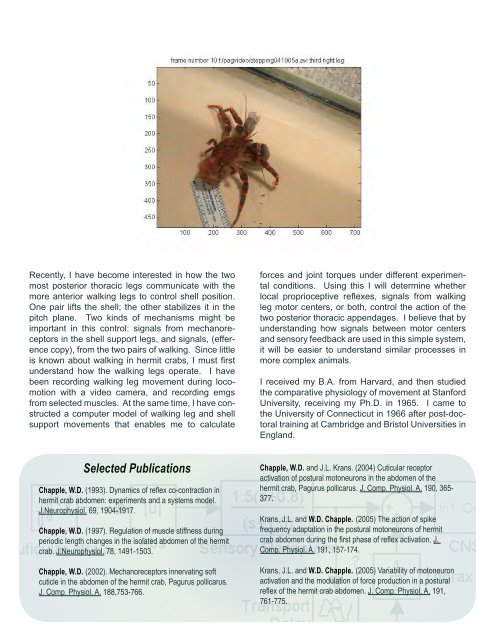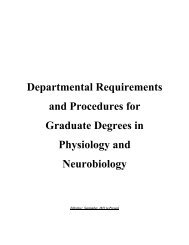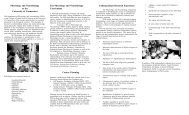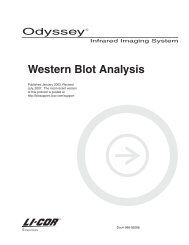Information Brochure (pdf) - Physiology and Neurobiology ...
Information Brochure (pdf) - Physiology and Neurobiology ...
Information Brochure (pdf) - Physiology and Neurobiology ...
You also want an ePaper? Increase the reach of your titles
YUMPU automatically turns print PDFs into web optimized ePapers that Google loves.
Recently, I have become interested in how the two<br />
most posterior thoracic legs communicate with the<br />
more anterior walking legs to control shell position.<br />
One pair lifts the shell; the other stabilizes it in the<br />
pitch plane. Two kinds of mechanisms might be<br />
important in this control: signals from mechanoreceptors<br />
in the shell support legs, <strong>and</strong> signals, (efference<br />
copy), from the two pairs of walking. Since little<br />
is known about walking in hermit crabs, I must first<br />
underst<strong>and</strong> how the walking legs operate. I have<br />
been recording walking leg movement during locomotion<br />
with a video camera, <strong>and</strong> recording emgs<br />
from selected muscles. At the same time, I have constructed<br />
a computer model of walking leg <strong>and</strong> shell<br />
support movements that enables me to calculate<br />
forces <strong>and</strong> joint torques under different experimental<br />
conditions. Using this I will determine whether<br />
local proprioceptive reflexes, signals from walking<br />
leg motor centers, or both, control the action of the<br />
two posterior thoracic appendages. I believe that by<br />
underst<strong>and</strong>ing how signals between motor centers<br />
<strong>and</strong> sensory feedback are used in this simple system,<br />
it will be easier to underst<strong>and</strong> similar processes in<br />
more complex animals.<br />
I received my B.A. from Harvard, <strong>and</strong> then studied<br />
the comparative physiology of movement at Stanford<br />
University, receiving my Ph.D. in 1965. I came to<br />
the University of Connecticut in 1966 after post-doctoral<br />
training at Cambridge <strong>and</strong> Bristol Universities in<br />
Engl<strong>and</strong>.<br />
Selected Publications<br />
Chapple, W.D. (1993). Dynamics of reflex co-contraction in<br />
hermit crab abdomen: experiments <strong>and</strong> a systems model.<br />
J.Neurophysiol. 69, 1904-1917.<br />
Chapple, W.D. (1997). Regulation of muscle stiffness during<br />
periodic length changes in the isolated abdomen of the hermit<br />
crab. J.Neurophysiol. 78, 1491-1503.<br />
Chapple, W.D. (2002). Mechanoreceptors innervating soft<br />
cuticle in the abdomen of the hermit crab, Pagurus pollicarus.<br />
J. Comp. Physiol. A. 188,753-766.<br />
Chapple, W.D. <strong>and</strong> J.L. Krans. (2004) Cuticular receptor<br />
activation of postural motoneurons in the abdomen of the<br />
hermit crab, Pagurus pollicarus. J. Comp. Physiol. A. 190, 365-<br />
377.<br />
Krans, J.L. <strong>and</strong> W.D. Chapple. (2005) The action of spike<br />
frequency adaptation in the postural motoneurons of hermit<br />
crab abdomen during the first phase of reflex activation. J.<br />
Comp. Physiol. A. 191, 157-174.<br />
Krans, J.L. <strong>and</strong> W.D. Chapple. (2005) Variability of motoneuron<br />
activation <strong>and</strong> the modulation of force production in a postural<br />
reflex of the hermit crab abdomen. J. Comp. Physiol. A. 191,<br />
761-775.





